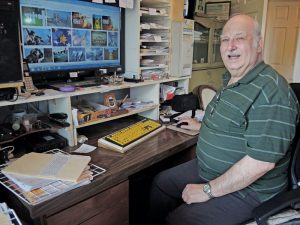Investigative prowess rights historical wrongs
By Lookout on Jun 12, 2016 with Comments 0

Peter Mallett, Lookout
Military historian Bart Armstrong conducts research in his Saanich home.
Peter Mallett, Staff Writer ~
For the past 16 years, Bart Armstrong, 67, a former military reservist, has spent his days pouring over historical records, microfilm and Internet sources to dig deep into our nation’s military past in order to right many historical wrongs.
Armstrong says his research has uncovered 109 recipients of the Victoria Cross with connections to Canada as opposed to the previously accepted number of 94, and determined there are 109 Medal of Honor recipients with connections to Canada who served for the United States as opposed to the recorded 69.
He is also big on pointing out that 50,000 Canadians served in the U.S. during the Civil War, something most Canadians are “completely oblivious to.”
“I am just scratching the surface with my work; there is so much out there about Canada’s military history, and, as a prominent genealogist recently claimed, an estimated 95 per cent of that information has yet to be revealed,” he says.
His most recent work resulted in the proper grave marker for U.S. Medal of Honor recipient Joseph Noil, an African-Canadian who travelled from his Nova Scotia home to join the U.S. Navy during the Civil War.
A series of unfortunate errors led to the sailor being buried without the prestigious head stone.
On the home front he worked with others to have a more prominent marker placed in honour of former HMCS Malahat Commander Rowland R.L. Bourke, the only known holder of the Victoria Cross and France’s Legion of Honour Medal from the First World War. Cdr Bourke received his medals for saving the lives of 41 servicemen during the 1918 spring raids at the Belgium ports of Ostend and Zeebrugge.
The history buff doesn’t mince words in his more than 400 “Sunday Evening” blogs on his website www.canadianmedalofhonor.com. The site is home to a comprehensive digital archive of graves, memorials and medals information, easily searchable, and available for other researchers and historians to access.
“You can type in the name of any soldier, sailor, aviator, ship or military institution and find out what I have written about,” says Armstrong.
“Most of the material is related to The Medal of Honor, the Victoria Cross, and also The Great Escape, one of my other preoccupations.”
His investigative sense comes from years working as a police officer, in the private investigation and security fields, and also as a journalist and advocate.
His love of military comes from his own service in three different regiments of the Canadian Armed Forces Reserves, and a long legacy of military service in his family lineage.
Add to his already brimming resume, he served as president of the Victoria Genealogical Society, and is the only Canadian member of the “Medal of Honor Historical Society of the United States”.
In humour, they refer to his home office as the group’s “Canadian satellite office.”
When the errors are corrected and result in high profile events such as the April 29 Noil ceremony in Washington, DC, which brought out top U.S and Canadian military and civilian officials, very few were aware of his and others’ work behind it.
However, he has received a few prized letters of praise from both U.S. and Canadian statesmen.
“More Canadians need to be aware about the importance of researching Canada’s history themselves,” says Armstrong.
“If they did this work they would eventually come to the conclusion our country’s strong, intricate ties to the historical legacy of the United States are something that needs to be celebrated.”
Filed Under: Top Stories
About the Author:





